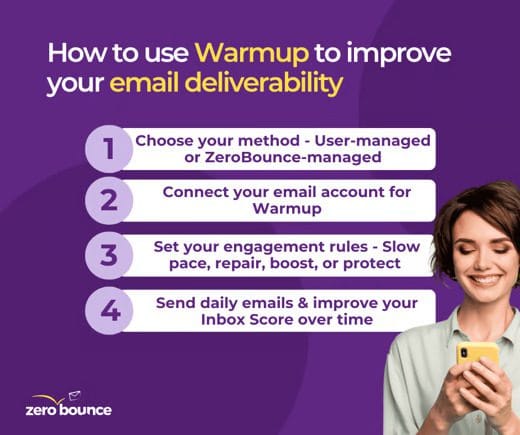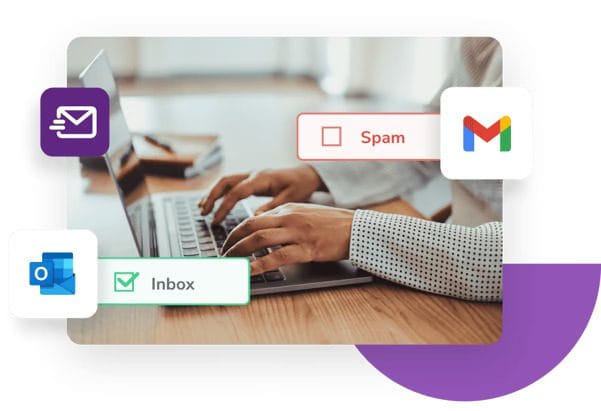
Chris Gallego, ZeroBounce: On Creating Emails That Convert – Without the Hard Sell
ZeroBounce’s Chris Gallego knows that the secret to email marketing is to be of service instead of trying to sell, sell, sell.
With 88% of consumers checking email at least once a day, email marketing is thriving. But tactics that used to be successful even a couple years ago don’t work anymore – in fact, they often turn people off. ZeroBounce’s Enterprise Success Manager Chris Gallego knows this firsthand after spending more than 15 years in sales.
In this interview, he breaks down the proven strategy of crafting personalized, concise emails that invite your ideal customer to take the next step.
Fret not, Chris has the answers on how to accomplish all of this, and talks about:
- The importance of an inviting subject line that isn’t spammy
- Why email warmup is crucial to improving deliverability and email marketing revenue.
- How to prevent spam issues in the first place
Chris’s tips come down to lots of common sense, and you can put these ideas into action right away. He’s also more than happy to answer any questions if you’d like to ask him personally.
For the full experience, watch the video interview of ZeroBounce’s Chris Gallego.
Chris, can you tell us a little bit about yourself and what you’ve noticed about email?
I’ve been with ZeroBounce for over six years, starting in the sales position that I’m still in now. I’ve learned that email validation is very important, not just for large companies but for small mom-and-pop companies as well. And email is one of the best ways to get in touch with someone.
Coming from a sales background and management background, I’ve learned that it’s a very intricate part of everyday sales. A lot of people communicate via email. A lot of deals get done via email. And a lot of promotions come via email.
So, for me, email is a way of not only speaking and reaching your clients but also helping me become the salesperson that I am today. And with over 15 years of sales, I’ve learned that you can do a lot if you can sell via email.
How to make more sales with emails
Chris, can you tell us how to make more sales with emails? What are the top three ways someone can do that?
One of the things that I like to do is personalize my subject line. And at the same time, you also have to focus on the body of the email.
First off, you want to make sure that your subject line is friendly. You don’t want to have a subject line full of fire emojis that says “Sign up now for a fire sale,” and more fire emojis. People will then look at that and say, “Hey, this is more of a spam than an actual email.”
If I were to send you an email that said, “ZeroBounce is offering you a 30% promotional discount. Sign up now,” you probably look at the email and then check out the body of the email.
When it came to the body of the email, I tried to sell in the past, and that was wrong of me — trying to sell via email. No, what you have to do is not only entice the client, but you also need to provide them with some type of information. What will my product — or what will the ZeroBounce product — do for them?
Keep it simple. Very short sentences because not everyone has time to read paragraphs. I receive multiple emails a day, and I don’t have time to read if, let’s say, Paul, you send me four paragraphs. I’m just going to say, “This is too long.” I’ll either put it to the side, or move on.
Pro tip: Did you know that 66% of consumers say they prefer short emails? Keep your messages to-the-point to get the most engagement from your audience.

But if I’m hitting the right points and letting you know, “Okay, you will receive 30% promotional pricing. But on top of that, here are other items that we have. We have a deliverability toolkit. We have 24/7 customer support.”
I try to provide that information in the shortest sentences that I can so that when I call them, they understand, “Okay, this is what you guys are providing.” And it’s simple enough that we want to move forward.
So have an enticing subject line but not too salesy and definitely don’t load it with emojis. It’s interesting that you mentioned body length because it’s true. There are statistics behind it. People prefer shorter emails.
Yeah. The third thing is follow-up. I’ve been called relentless in the office because I will follow up with clients, whether they have purchased credits with us or they’ve gone to another vendor.
And I’ll still follow up with them and just let them know, “If you’re not happy where you are, we’ll be more than happy to assist you.” Or I’ll let them know the things that we’ve done to change and how we are a much more viable company for them. And if they have questions, there’s always someone here to help them. And I’m always available.
So follow-up is very important, and that’s in any industry. But with email, you’re able to take that extra step and make it more personalized. And not just, “I’m reaching out to you to say, are you still in the market?”
Instead, it could be something else. “Does it make sense to set up a call and see if everything’s working out? Just wanted to reach out to you in that aspect.”
It doesn’t always have to be “salesy,” guys. I do that all the time. I try to enhance the email by just saying something as simple as, “Let’s get on a call and see if you need something from us.”
And I try not to pitch them like, “Oh, do you still need to make a purchase, or are you still in the market?” No. Because sometimes they’re just going to say, “No, thank you.”
Getting to the bottom of email deliverability issues
People are coming to ZeroBounce for a reason. What are the most common challenges that you find customers are facing?
What I’ve found is that a lot of our clients or potential clients are coming in with deliverability issues.
A lot has changed in the email world in the last few years. I like to say it’s not the wild, wild West anymore. It’s more about quality instead of quantity.
Ten years ago, if you had 10 million emails, you were going to make money any which way. Now, 10 million emails that are not valid or have no interactions don’t mean anything because the whole goal is to:
- reach the inbox
- get an open
- and ultimately, to either set up a call or make a sale.
Now, it takes more than just validation to reach the inbox. You need to have warm IPs, a warm domain, and all your settings set up properly. This is only one part, but this is where we provide the customer on the ZeroBounce platform added value with our email deliverability toolkit.
That helps them not just analyze their servers or see if they’re landing in the inbox, but it also helps with taking that next step — making sure they’re not hitting the spam box or going to the promotions tab with Google or any other email client.
So deliverability is very important. I just had a client yesterday whose emails were all going to spam, and they didn’t know why. Well, there are many reasons why that can happen.
One, you hit a spam trap — you didn’t know it, and it snowballed into a bigger problem. Your IPs were blacklisted. Your domain was blacklisted. There are other underlying issues that a lot of people don’t know about.
That’s where we come in. We try to provide those clients with a passage through all of these problems and give them a solution. Deliverability is not easy. It’s gotten more complicated in the last several years.
I’ve been in this space, and I’ve seen it get more and more complicated — to the point that some of our clients now have to use a consultant because their reputation is so bad that even validation is not good enough anymore.
And we do have a consultant with ZeroBounce whose expertise is deliverability. We try to provide his expertise to our clients.
Even on our website, we have a path that says “Email Deliverability,” and it’s a simple way of reading what you should do and what you shouldn’t do when you’re sending out emails and setting up your infrastructure.

Taking the right steps to land in the inbox
What is the biggest reason why someone will end up in a situation where their emails end up in the spam folder?
First off, some of the main reasons are that people don’t want to accept that their list is old. They continue to email it, and once an email becomes a honeypot, they keep emailing it without recognizing the risk. If you have a database that is over two years old, you should be validating — that’s your number one defense.
Pro tip: On average, 28% of your email list decays every year. Remember to validate it quarterly and remove obsolete and risky contacts.
Or, if you’re collecting data, using an API will assist in removing any junk or any unreputable signups on your website. It doesn’t matter how much data you have. What matters now is the quality of your data.
What I’d like to point out is that you should reach out to us. We’re here to consult and to provide you with information. You don’t need to purchase anything. We’re here to help you out.
If you follow these key ways of handling your data, it will become much easier for you in the future when you’re collecting data and sending out your campaigns.
Taking the right steps to land in the inbox — it’s not easy, guys. But I will say this: if you start now, like anything else, and start putting it into your roadmaps that these are the steps you need to take, you’ll see that it just becomes very easy over time.
And it’s a no-brainer to say, “Okay, we’re going to start applying our API to forms and validating those emails in real-time.” That way, we don’t have any junk, we don’t get flagged as a spammer, and we don’t hit any spam traps.
So to me, that’s very important, and I like to share information with anyone who reaches out. And that applies to anyone you reach out to on the ZeroBounce team.
Understanding email warm-up
Many people are asking about this term, email warmup. Can you explain email warmup to me like I was in the fourth grade?
I understand it’s complicated, even for someone like me who is in this field. Then, I saw it as very simple. Let’s put it this way:
Paul creates a new website, has a new domain, has his IP, and it’s dedicated — not shared. Because I like to tell clients to use a dedicated IP and a secondary domain to send out their campaigns.
So, Paul set up a new website, has a new domain, a new IP, and a list of 10,000 emails. He’s going to send them emails about his new website and his new product.
His content is good. He also validated his list, and his subject line is pristine. The weight of his email is right — he’s taking all the steps to make sure that everything is correct.
But he forgot one step: warming up his IP and his domain.
So what Paul doesn’t know is that if he sends out all 10,000 emails at one time, ESPs are going to recognize whether this domain or IP has sent emails to these recipients before. Every email gets read by ESPs, and they know where it’s coming from.
If they see that they’ve never received anything from a domain or IP before, and suddenly, there’s a huge volume of emails coming in all at once, they look at that as spam. And just like that, Paul has triggered them to start sending him straight to the spam folder.
When you warm up, it’s warming up your IP. It’s warming up your domain. Basically, it’s nurturing your deliverability. That way, when you send out your list of 10,000, you’re not going to get flagged as a spammer.
Why? Because of what you’ve been doing to prepare. Two weeks before you start your campaign, you start warming up your IPs and your domain.
Previously, this had to be done manually. You started off with two emails the first day, then doubled it the next day, and continued to do that to all the largest ESPs. Now, there’s automation. And that’s a great thing because now you don’t have to do all that heavy lifting — we can do it for you.
It’s a very simple step: sign up with ZeroBounce, select warm-up, and add your IP and domain to our platform.
We do all the heavy lifting for you. We do the click-throughs to show that emails are being accepted by the ESP you’re going to be sending to. That way, when you start sending out your campaigns, the ESP sees, “Oh, we’ve received emails from this domain and this IP before—they’re good to go. We’ll allow them.”
And you don’t get flagged.
Warm-up is really important now, guys, because even if you have a list of 10,000, you can still get flagged. And most importantly, you want to land in the inbox. Our goal for you is to make it as simple as possible, to make it as friendly as possible, and, obviously, to show you your deliverability and your gains.

Preventing spam issues in the first place
For that person out there who’s thinking, “Chris, I don’t want to end up in the spam folder. I don’t want to have all these problems.” What would you say are the three things that they can do to avoid even having this problem in the first place?
Reach out to someone at ZeroBounce — that’s number one, I would say. We are here to assist our clients or potential clients. Or even if you’re just looking for information, the first thing is: to reach out to me. I’m here.
We have a large staff that’s available to help, with 24/7 customer support and technical support. So if you have questions, we’re here to assist you.
Next, make sure you take advantage of our free tools and validation platform. That’s a crucial step.
Right. You get 100 free credits, right? Isn’t it 100 free credits a month?
That is correct. And you also get:
- One free inbox placement tester, which allows you to check if you’re landing in the inbox or the spam box.
- One blacklist monitoring to see if you’re getting flagged, whether it’s your IP or your domain.
- A server tester, which lets you know if you’ve configured your server correctly. It can be something as simple as missing MX records that will land you in the spam box. And I’ve seen that happen before.
So, take advantage of these free tools. Now, if you need DMARC or warm-up, those are paid services. But we always have promotions, so reach out to us and take advantage.
And finally, number three — do some reading. Take advantage of what we have on our website. I recommend the resource The Complete Deliverability Guide for Email Marketing Success.
These are sources we’ve compiled from our marketing partners and the large companies we work with. Some of these companies have unlimited funding, and we’ve gathered that information and are giving it to you for free.
No charge. No gimmicks. No need to enter a credit card just to look at this. It’s all there for the taking.

Always improve and you won’t go wrong
Chris, what can everybody out there do today to make today a better day?
I like to say, write a great email. Don’t sell anything.
Write to your best client and say, hey, what am I doing good? What am I doing right? And can I improve?
I always like to ask my clients that. How can I improve? Can I make your journey any better? And I don’t take it personally. I just take it as information for myself to become a better — I don’t want to say salesperson — but a better person. Not just for my job, but for me personally.






